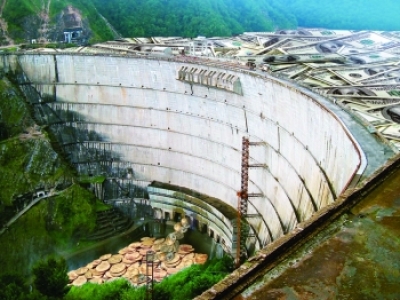
Georgian government awaits stabilization of the national currency’s exchange rate in 2-3 weeks – right after the Gardabani Thermal Station is sold for 300 million USD and the tourist season begins. However, nobody can tell for certain for how long will the aforementioned 300 million hold the currency afloat or whether the country will experience the tourism boom the way it usually does in summer.
In August of 2014, Georgian government has announced its interest in the project of creating deepwater port in Anaklia. The idea of building a seaport there belongs to the previous government; moreover, ex-President Saakashvili even wanted to build an entire city to go with the port. The current government hesitated and toyed with the idea for some time, then conducted a research and eventually decided to proceed with the port. Twelve companies have immediately expressed their interest in the project; out of them, only seven were shortlisted by the governmental commission.
They were given time until April 16 to make their offers, complete with technical and financial specifications. In the end, only two companies have managed to make satisfactory offers. September will reveal who will end up building the port – Georgian-Chinese company Anaklia Port and Industrial Eco Park or a joint enterprise by KONTI Group and TBC Holding. Aside from the port itself, it is planned to develop a logistical and industrial zone in its vicinity, as well as build an international airport and a liquid gas terminal there.
Construction of the Anaklia port will begin in 2016 and will be pided into 7 phases. The port is planned to have a capacity of 100 million tons and an investment cost of 5-6 billion dollars.
Another 800 million dollars are expected to enter the economy from rehabilitation and development of Tskaltubo spa resort. This project was also incepted by the former government and is now resumed. Austrian company Kohl & Partner has helped with zoning of the resort and currently French company Vichy is conducting international certification of the resort’s well-known mineral water springs.
In addition, mobilization work is expected to begin in summer in order to lay foundations for Nenskra Hydropower Plant, with the total price of the project expected to be 1.1 billion USD.
However, it is currently unknown what fate awaits massive and ambitious projects such as Khudoni Hydropower Plant and a railroad bypassing Tbilisi, which are also expected to provide Georgia at least a billion dollars in investment.
Levan Kalandadze, head of Infrastructural Project Initiative:
“It would be wrong to say that putting all of these projects into motion simultaneously could have allowed us avoid the currency crisis completely, but it would’ve helped us stop depreciation of the lari. Instead of a 30 percent exchange rate plummet, we could have gotten a 15-16 percent one.
When discussing such large-scale projects and their investment value, we should keep in mind that the investments involved are not single-use, so to say. The Anaklia port project will take 10 years to build, Khudoni will take 6 or 7, Nenskra is expected to take 4... This means that foreign currency inflow will be gradual.
Unfortunately, the risk factors that have put the lari in such a sorry state are still there. Development is difficult, but we have a so-called gold reserve for cases such as this – investment projects, which, if carried out sensibly and in a timely fashion, will allow us to be rid of the risk factors that keep our currency down.”
Author: Ema Tukhiashvili
v-if="article.gallery" v-html="article.gallery"
(adsbygoogle = window.adsbygoogle || []).push({});